| Columns Retired Columns & Blogs |
Conrad-Johnson ACT2 line preamplifier Measurements
Sidebar 3: Measurements
The Conrad-Johnson ACT2 proved unfussy about grounding, which is always a good thing in a preamplifier. With the volume control set to "99," the maximum, its voltage gain was 20.5dB; the unity-gain setting was "76." The single-ended circuit inverted signal polarity, which should be compensated for in comparisons with other preamplifiers. The input impedance was a high 68k ohms over most of the audioband, dropping to a still fairly high 22k ohms at 20kHz. The output impedance was a fairly low 502 ohms in the midrange and treble, increasing to 1150 ohms at 20Hz. This is still sufficiently low that there won't be any leaning-out of the bass into power amplifiers with input impedances as low as 10k ohms.
The ACT2's frequency response depended on the setting of the volume control. With it set to its maximum (fig.1, bottom pair of traces above 2kHz), there was a noticeable top-octave rolloff, with the output down 3dB at 24kHz. This is an extremely unlikely situation, however. With the control set to unity gain (fig.1, middle traces), the output was now flat in the audioband and –3dB at a high 160kHz; when the preamp was used to attenuate the input signal—the most likely scenario with digital sources—its bandwidth extended to well above 200kHz.
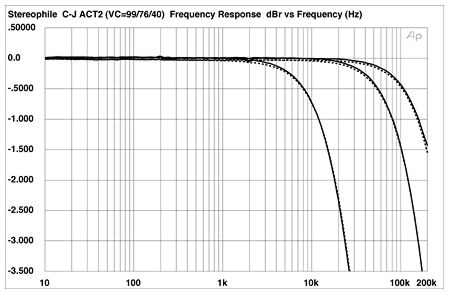
Fig.1 Conrad-Johnson ACT2, frequency response at 1V into 100k ohms with volume control set to "40" (top above 20kHz), "76" (middle), and "99" (bottom above 2kHz). (0.5dB/vertical div., right channel dashed.)
Note the excellent volume-control channel matching in fig.1. The channel separation (fig.2) was only fair at high frequencies, due to capacitive coupling, perhaps at the volume control. But it was better than 80dB in both directions in the midrange, which is fine.
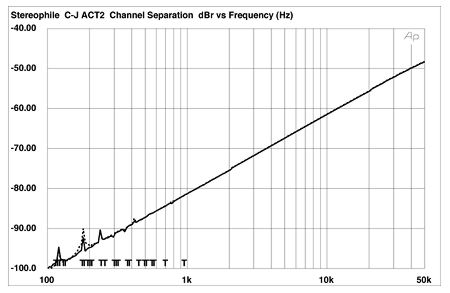
Fig.2 Conrad-Johnson ACT2, channel separation (10dB/vertical div., R–L dashed).
As is traditional with Conrad-Johnson preamplifiers, the ACT2 offers excellent dynamic range. Fig.3 shows how the percentage of distortion and noise varies with output voltage into loads ranging from a very high 100k ohms to a low 600 ohms. The preamp offers 8V or more at 1% THD into loads of 10k ohms and above, but lower voltages into admittedly unrealistically low loads: 2.5V into 1000 ohms and 1.3V into 600 ohms. However, it is fair to note that the circuit is nowhere near clipping at this distortion level. Instead, the positive-going halves of the waveform just become increasingly rounded off, leading to increased asymmetry. The rising trend with decreasing voltage below a few hundred millivolts in this graph, which was taken with the volume control set to "99," indicates that the measured percentage is actually dominated by background noise at these levels. The true distortion level is at or below 0.1% into high impedances, and there is no change with frequency into any load (fig.4). Given that the noise level will be lower with the volume control set to give unity gain or less, the preamplifier's noise floor is sufficiently low.
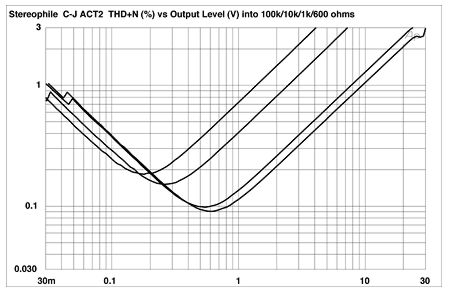
Fig.3 Conrad-Johnson ACT2, distortion (%) vs output voltage at 1kHz into (from bottom to top): 100k, 10k, 1k, and 600 ohms.
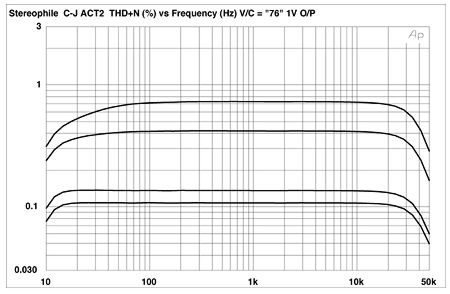
Fig.4 Conrad-Johnson ACT2, THD+N (%) vs frequency at 1V into (from bottom to top): 100k, 10k, 1k, and 600 ohms.
As figs.3 and 4 reveal, the ACT2 is definitely more comfortable driving higher impedances. But its relative lack of linearity into low loads will be less of an issue than might be thought, given that the distortion content is almost pure second harmonic, which is very hard to hear. This is shown graphically in fig.5, the spectrum of a 1V, 1kHz tone driven into 8k ohms, about the lowest load the preamp would see in a real-world system. The second harmonic lies at –57dB (0.14%), but the only other harmonics visible are the third, just below –100dB (0.001%), and the fourth, at –11dB (0.0003%)—both well below audibility.
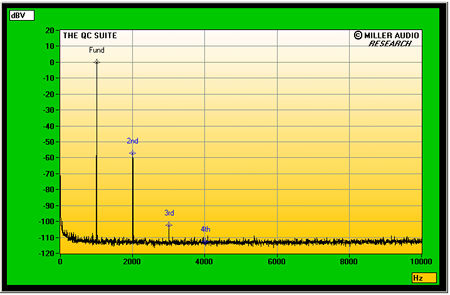
Fig.5 Conrad-Johnson ACT2, spectrum of 1kHz sinewave, DC–10kHz, at 1V into 8k ohms (linear frequency scale).
The tradeoff with a circuit offering the subjectively innocuous second harmonic is the danger that there will be highish levels of intermodulation distortion. However, at the same 1V output level into 8k ohms, an equal mix of 19kHz and 20kHz tones produced just 0.07% of the 1kHz difference component (fig.6), suggesting that the C-J's designers have optimized the circuit's behavior for real-world use.—John Atkinson
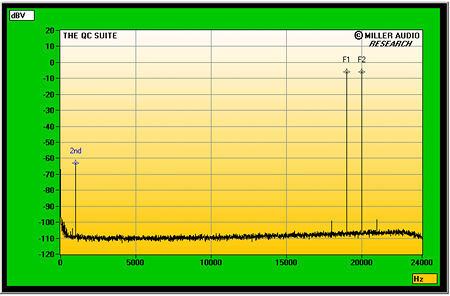
Fig.6 Conrad-Johnson ACT2, HF intermodulation spectrum, DC–24kHz, 19+20kHz at 1V into 8k ohms (linear frequency scale).
- Log in or register to post comments




































